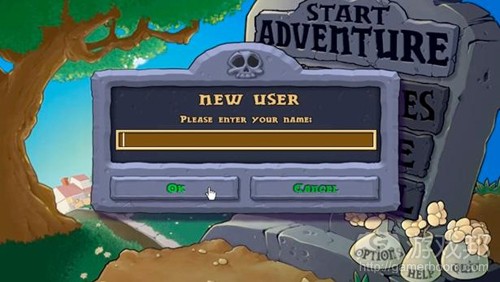以《植物大战僵尸》解析休闲游戏设计要点
作者:Graham McAllister
好游戏的标准一直备受争议,但是绝大多数人认为,容易进入但却难以释手就是优质游戏的普遍特征。玩家在初级的游戏体验很关键:因为正是在那时候他们才会决定是否继续向其投入时间和金钱。
所以我们要如何做才能在游戏初期就为玩家提供最棒的体验?让我们以PopCap的《植物大战僵尸》为例,一起学习好游戏是如何炼成的。
在游戏初始阶段中很多新玩家会因为某些原因而放弃游戏。这个过程经常被比作漏斗:很多潜在玩家对你的游戏很感兴趣(游戏邦注:这里指漏斗较广的那一口),但是随着游戏的进行都会有一些因素导致玩家离开游戏。你自然希望在最狭小的漏斗口能够出现足够的玩家,从而才能让游戏获得成功。
这个漏斗中的每一阶段分别是什么?《植物大战僵尸》是如何确保更多的玩家能够“挤过漏斗口”?让我们把这一漏斗分成5个主要部分,并分析每一部分的最佳范例。
1.游戏开始前
这个阶段包括游戏介绍视频和角色创造,但是《植物大战僵尸》却未出现这一阶段。玩家只需要载入游戏并输入名字即可。PopCap希望玩家能够马上进行游戏。
2.菜单
出于某些原因,菜单可以说是游戏设置中的一大真正阻碍。首先,你提供了越多菜单,玩家就可以获得更多选择,但这也将延迟他们进入游戏的时间。其次,你提供了越多选择将会让玩家感到迷惑。一些玩家会因为某些术语而疑惑,也会害怕做出错误选择而犹豫。所以应该尽可能减少游戏中的菜单,特别是在“休闲”游戏中,以此挽留住更多玩家。
《植物大战僵尸》在这方面便做得很好。它只提供了一种游戏模式并让玩家能够立马开始游戏。游戏中没有任何难度等级设置,也不会弹出任何窗口需要玩家费神。可以说这款游戏把所有不必要的阻碍因素都剔除掉了。
这一阶段最有趣的地方在于,玩家选择是否继续游戏,以及决定开始游戏之间所花费的时间恰好是12秒。前7秒展示了“PopCap出品”,后5秒播出了介绍游戏玩法的有趣视频。很多玩家对于那些把自己的logo和介绍影片放在游戏前的公司感到不满,因为他们只是来玩游戏的。而PopCap的做法是先让玩家玩游戏再播放游戏的相关视频。我认为这么做会让玩家更加满意。
3.新手教程
解释游戏规则很重要,但是如何做好这一点就很难了。最简单的方法便是使用文本操作指示向玩家解释游戏中的每一机制和界面元素,但是绝大多数玩家并不会去阅读这些指示。《植物大战僵尸》只向玩家解释了核心游戏功能,即植物和太阳。它鼓励玩家能够通过游戏操作而进一步探索并掌握游戏规则,比起强迫玩家去学习,这种方法更有效。《植物大战僵尸》为玩家创造了一个安全的游戏环境,即玩家可以在游戏初始阶段可以边学习边进行游戏,且不用担心输掉游戏。在这里每个人都是赢家。
4.通过奖励提高玩家粘性
现在我们吸引了玩家的注意力,那么我们要如何做才能留住他们呢?《植物大战僵尸》通过引进一些新的植物,僵尸,小游戏等功能而留出玩家的注意。当然了,他们的这一做法很明智。
在游戏的前八个关卡结束前,玩家都能够得到游戏赠送的新植物。这么做将能鼓励玩家继续挑战下一个关卡,除此之外游戏也使用了其它策略。例如,玩家在游戏中途不能轻易退出;当你完成一个探险模式关卡时,游戏并未提供选择让玩家决定继续游戏或者退出游戏。而是自然地跳到下一个关卡。玩家将有可能带着好奇心去尝试下一种新的植物,而继续进行游戏。
这种模式一直维持到第八个关卡,而直到那时候玩家至少已经花费了30分钟玩游戏,而且这30分钟时间也是经过巧妙设置的。这就像是一个演示版本,让用户体验30分钟将有可能因此提高游戏销量。
5.鼓励玩家重返游戏
有时候玩家会停止游戏,但是你应该想想如何做才能让他们重返游戏。日本作家村上春树曾经说过:“在写小说的时候,当我感觉到自己可以写得更多的时候我便会停下来,而在隔天重新开始创作的时候便会更加顺畅。”《植物大战僵尸》便使用了这一哲理。很多玩家在一个关卡结束后便会关掉游戏,但是如果能在这时给他们一个新的植物,那么即使他们离开了,也会有动力再次回到游戏中。
《植物大战僵尸》在游戏初期体验的设计中表现突出。PopCap在鼓励玩家长期进行游戏上的技巧多种多样,这里我们还仅涉足其中的一小部分内容。
《植物大战僵尸》最聪明之处便是同时迎合了硬核玩家和休闲玩家的需求。PopCap表示,他们的销量在硬核游戏玩家和大众用户之间各占一半的比例,而我们也很容易能够看出原因:休闲玩家在游戏中受到了鼓舞,而硬核玩家则可从中接受各种挑战或者制定出新的战略。
制作出如此巧妙的机制并不容易,同时也需要不断地改进与完善。PopCap花了3年的时间开发出了《植物大战僵尸》,在早期便确定了游戏原型,并随之进行了多次的游戏测试进行完善。不管怎么说,创造休闲的游戏乐趣需要付出巨大的努力。(本文为游戏邦/gamerboom.com编译,如需转载请联系:游戏邦)
Plants Vs Zombies: Introduction to perfection
Graham McAllister
Graham McAllister presents the five reasons why Plants Vs Zombies is a masterclass in experience design.
The formula for the perfect game may be an area of hot discussion, but most would argue that games that are easy to get into and difficult to put down goes along the right lines. Players’ early experience of a game is critical: this is the period in which they’re making up their minds whether to devote more time, and often money, to the rest of it.
So how do we make games with a polished early experience? Let’s take some lessons from a game which I think does it incredibly well, PopCap’s Plants Vs Zombies.
There are many points during the opening of a game at which a new player may decide to stop playing. This process is often visualised as a funnel: you have many potential players interested in your game (the wide part of the funnel), but each progressive step has the potential to cause players to leave. The hope is, of course, that enough players emerge at the narrow end of the funnel to make the game a success.
So what are these steps in the funnel, and what does PVZ do to ensure that as many players as possible squeeze through funnel? Let’s divide the funnel into five key sections, and look at the best practices in each.
1 Pre-game
This step might include a game intro video and character creation, but PVZ doesn’t. The game loads and you just have to enter your name. You wanted gameplay, you’ve got it; PopCap wants you to get to the action right away.
2 Menus
These can be a real barrier to gameplay for several reasons. First, the more menus you offer, the more the user may explore, each one delaying time taken to get to the game. Secondly, the more choice you offer, the more you may confuse the player. Some players may feel confused by some of the terms used or be scared of making a wrong choice. Reducing the number of menus, especially in “casual” games, lessens the possibility of players leaving.
PVZ is masterful here, offering only one game mode and immediately beginning. There is no difficulty level, no pop-ups to dispatch. All unnecessary friction has been eliminated.
What’s interesting at this point is the delay between selecting the option to play and the time taken to actually start the game – 12 seconds. The first seven seconds of that is displaying ‘PopCap Presents’, then a further five-second action-packed gameplay movie. Other studios put their logos and intro movies up front, causing frustration for some players, because they’re here to play the game. PopCap gives you the game, then shows the gameplay movies. More satisfying? I think so.
3 Tutorials
Explaining a game’s rules is crucial, but it’s an art to do it in a best-practice way. The easiest option would be to explain every mechanic and HUD element by providing wall-of-text instructions, but few players will read it. PVZ explains only the core game features – plants and sun – and that’s it. It encourages the player to explore and learn by doing, which is much more satisfying than learning by being told. PVZ also creates a safe environment in which to learn as it’s impossible to fail the first level. Everyone’s a winner.
4 Player engagement
Now that we have the player’s attention, how do we keep it? PVZ employs several strategies to keep players keen by introducing new plants, zombies, mini-games, and other features. What’s clever is how it does this of course.
At the end of each of the first eight levels the game awards the player with a new plant. This alone will encourages them to try it out on the next level, but the game also employs other tactics. For example, it’s very difficult to exit the game; when you complete an Adventure mode level, the game doesn’t offer the option to continue to the next level or quit. It simply starts the next level. Combine this with the curiosity to try out a new plant and chances are that you’ll continue.
This pattern repeats until level eight – by now, the you’ve has spent at least 30 minutes with the game, and a very precisely designed 30 minutes at that. If this were a demo, chances of a sale are looking good.
5 Encouraging return
At some point, players will stop playing, but how do you bring them back again? The author Haruki Murakami says, “When writing a novel, I stop every day right at the point where I feel I can write more. Do that, and the next day’s work goes surprisingly smoothly.” PVZ uses this exact philosophy. Most players would typically end a game session at the end of a level, but by giving the player a new plant at this exact point, even if they do leave, an incentive has been created to come back.
PvZ is a masterclass in early experience design. We’ve only touched on a handful of the techniques PopCap uses to deliver an accessible game that encourages long-term play.
What’s amazingly clever about PVZ is that it works for both core and casual users. PopCap says that its sales are an equal 50/50 split between core gamers and broader audiences, and it’s easy to see why; casual users feel supported whilst core users can issue themselves challenges or try out new strategies.
This level of polish doesn’t come easy, of course. It requires refinement, and lots of it. PopCap spent three years developing PVZ, prototyped early and playtested often. Casual fun requires serious effort.(source:next-gen)
上一篇:阐述如何拯救行业中的冒险题材游戏









































